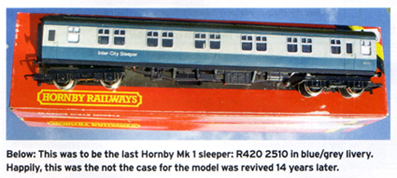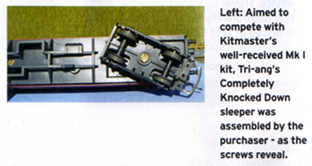Article
Milestone Models: Tri-ang Sleeper
Author: Robert Forsythe
Date: 22 February 2011
Related Model: B.R. Second Class Sleeping Car
This article originally featured in the August 2010 edition of the Model Rail magazine.
Today, we take scale-length ready-to-run coaches for granted but it wasn’t always so. Robert Forsythe recalls the stir caused by one of the first.
May 1961 was when an advertisement in the British railway modelling press proclaimed: “Scale Sleepers Cheaper”. The subject may have, at first glance, been any old BR sleeper. But it was much more important than that.
It was the first full-scale, fully detailed, ready-to-run 64ft BR Mk l coach. This was a model of such quality that it could be revived after a 14-year break.
BR’s first standardised coach - the Mk I - was introduced in 1950, the sleeper version coming in 1957. It is a British design classic and that was sufficiently evident in the late 1950s for model manufacturers to tum to them. However, each offering had flaws until the arrival of Tri-ang’s sleeper.
Tri-ang had offered an earlier range from 1956 known as the ‘9in’ coaches. They were too short apart from the non-corridor stock.
But four rivals were on the prowl in 1961. Trix announced a new range of scale Mk Is at that years toy fair. These were finally released in 1964, Highly regarded in some quarters, they were always bedevilled by being made to Trix’s peculiar 3.8mm:1ft scale.
Hornby Dublo released its first Mk Is in December 1960. Again, they were too short and aside from the Mk I horsebox, production lasted for four years.
It was Kitmaster that really made Tri-ang take note.
Its Mk I coach kits were scale length, popularly priced and had flush glazing. They were really well received when released in early 1960. Yet Kitmaster’s demise in 1962 and the subsequent destruction of its Mk I coach tools led to the kit’s rapid disappearance from the scene.
There was a fourth player, too. This was Mettoy/Corgi’s model railway brand Playcraft Railways.
Dirt cheap, Mk Is were part of its line of British models launched in the autumn of 1961. Made by Jouef to ‘HO’ scale, their advent continued that everyone seemed to be enthralled by Mk Is in the early 1960s - apart from Graham Farish.
Tri-ang’s Response
Tri•ang responded to the competition over the next two or three years in an astonishing burst of creativity of which the Mk Is were just one aspect. In 1961, there was just the sleeper with its retail price of 10s 11d. Choosing the sleeper as the start of a scale-length range of Mk Is made all sorts of sense.
Previously, Tri-ang had no sleeper in its ‘OO’ range (the ‘TT’ version also came out in 1961). Only Hornby Dublo already offered one, which was just a couple of months old. None of the other early-1960s players would add more sleepers. Tri-ang’s development costs were eased by using the existing bogie from the ‘9in’ series. There was no interior (there never would be) although apart from the always-too-long BG, the other scale-length models - dubbed ‘10in’ - came with one.
Unlike the ‘9in’ series which had an integral body and chassis, the new coach had separate sides, roof and underframe. This allowed future variations, an economy that Tri-ang took full advantage of in the years to come. There were promises in 1961 of flush windows. This finally materialised in 1996!
It was no surprise that the sleeper was warmly welcomed. Development continued and other Mk ls were launched in 1962. Tri-ang also directly confronted Kitmaster that year with the Completely Knocked Down (CKD) version. It realised that something else could be shaved off the price and further ‘fun value’ extracted by retailing unassembled components.
The saving for the company was not so clear as packaging became grander and more complex for the CKD models. They were supplied in pairs with running numbers 2510 and 2511. As R381, these were only produced from 1962-65.
After l962, the sleeper and the other ‘10in’ Mk Is in carmine/cream, maroon and Southern green - were an integral part of the Tri-ang range. The sleeper was only available in maroon. although it appeared in blue/grey after 1968.
The Prototype
BR built four types of sleeper. They shared the same body, and the classification depended on the interior layout. Tri-ang’s 1961 coach was R339 Sleeping Car Second With Pantry. Running number 2510 was used. 1962’s models sported new miniature B1 bogies produced for the ‘10in’ series. Even so, the very first of the new bogies had sleeved axles in closed axle boxes. These were replaced by metal pin-point axles.
The real 2510 was built at Doncaster in 1957 and lasted into the 1980s. It had a different corridor and compartment side. Thus Tri-ang produced two sides with correct door, ventilator and window positions. Likewise, a special roof moulding had the distinctive linear vent.
After 1974, the now ex-Tri-ang sleeper sported B4 bogies. Many of the prototypes had been so altered by this stage. For the model, it merely meant fitting the bogie used under Tri-ang’s Mk 2s.
All plastic wheel sets appeared around this time along with the provision of ‘chrome’ window frames (a touch overdone, I think), While the 1974 Hornby catalogue entry showed this, a rake illustrated underneath had a sleeping car with all the alterations bar the chroming.
The year 1975 passed without change to the catalogue picture but a rake on page 29 had a coach branded ‘Inter City Sleeper’. This certainly never appeared in the shops in 1975.
In 1976, ‘Inter City Sleeper’ branding finally appeared. Together with ‘Silver Seal’-style metal wheels led to an ‘R’ number change: R924 BR Blue/Grey Sleeping Car Second With Pantry.
Oval buffers arrived in 1977 and in 1978 the riveted bogies were replaced with press-fit ones. This facilitated R449 interior lighting unit in 1978.
The reason for a final ‘R’ number was the adoption of a blue/grey paint finish in 1980 to become R420 Sleeping Car Second With Pantry. 1982 brought a reversion to white rimmed plastic wheels. After that it seemed that the story was over...
Back To The Future
I can remember it was quite a heart- thumping moment in 1996 to be told that Hornby was to reintroduce its Mk Is. The surprises kept coming because flush windows were introduced.
One of the two 1996 releases was R433 BR Maroon Sleeping Car First W2105. For the first time since 1961, a First Class sleeper was produced. As it had no interior, all that was required was different lettering.
Since then, ten Mk I sleepers have appeared, including 2510, this time as R461 E25l0. Today, R4202A (M2020) is the only Mk I sleeper available. That’s not a bad return on Tri-ang’s investment, is it?
Photography: Robert Forsythe
www.forsythe.demon.co.uk
REPRODUCED COURTESY OF MODEL RAIL MAGAZINE/ROBERT FORSYTHE




















